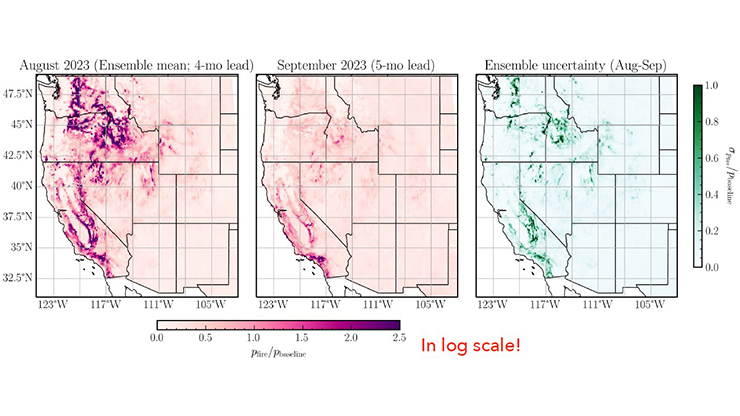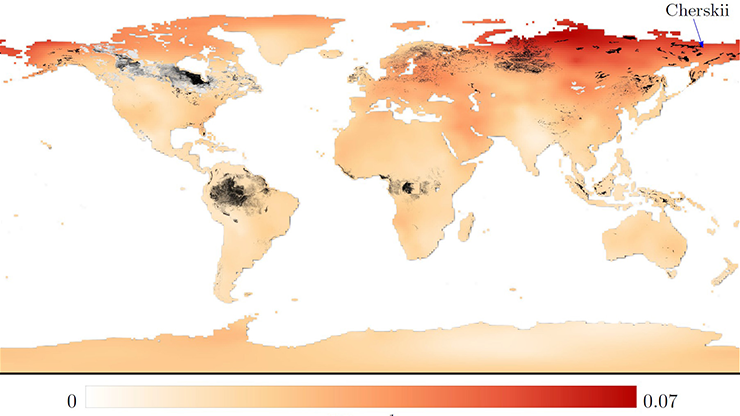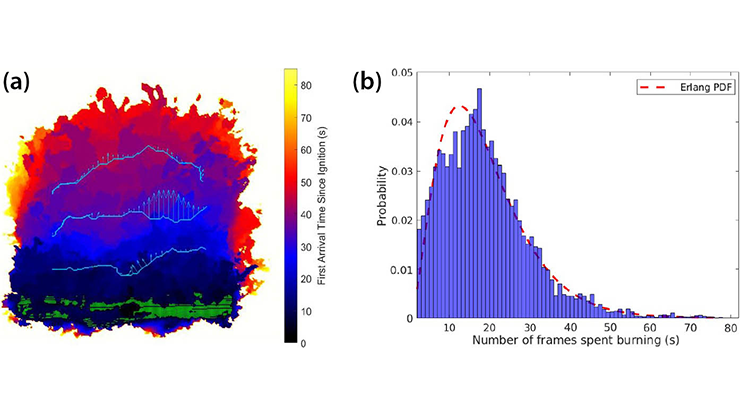Experiments and Simulations to Study Flow Through Vegetation During Wildfires
“Fire is a very complex phenomenon,” Albert Simeoni of Worcester Polytechnic Institute said at the Third Joint SIAM/CAIMS Annual Meetings (AN25), which are taking place this week in Montréal, Québec, Canada. “There are a lot of things that we do not understand very well.” Numerous different processes happen in concert during a wildfire; atmospheric effects have a role to play, as does combustion in vegetation.

During a minisymposium presentation on joint work with Navya Muniraj, Weixuan Gong, and Muthu Selvaraj of Worcester Polytechnic Institute, Simeoni addressed the flow of air and smoke through forest canopies and individual trees at fire fronts. “I’m going to look at different viewpoints on drag and how it influences the spread of smoke in wildfires,” he said. Fundamental knowledge on this topic is still in need of further development, and Simeoni has been revisiting some common assumptions in wildfire modeling to investigate whether they stand up to scrutiny. His AN25 talk covered several different approaches to this multifaceted problem, combining aspects of experimentation, modeling, and simulation.
“Of course, when we face this complexity, we try to decouple things,” Simeoni said. He first illustrated the calculation of drag forces on a single particle with various geometries. Early fire models generally used spheres for the single particles, but as Simeoni noted, spheres do not appear particularly often in nature — especially in forests. It is usually more relevant for simulations to incorporate single particles in the shape of cylinders (to represent pine needles, for example) and flat sheets (to represent leaves).
This type of geometry is an important decision in fluid modeling, as Simeoni demonstrated by showing the difference in the dynamic drag coefficient for a sphere versus a cylinder. “This is a strong indication that if you want to get into detailed simulation, the shape might matter,” he said. While these single particle simulations are a reasonable first foray to investigate the fluid dynamics in a fire situation, they cannot adequately represent a branch, for instance, or an entire plant.

Moving along to a much larger scale, simulations of a swath of tree canopy often assume a homogenous distribution of leaves on the lateral plane, with leaf density only varying by height. Based on the literature, this assumption seems to enable decent simulations of wind and smoke flow through the canopy. Tree canopy on a large scale—like in a forest—will tend to homogenize the flow.
The problem becomes much more complex when trying to simulate the flow around a single tree, which incurs more three-dimensional effects. Yet solving this problem is an important goal, since the distribution and shape of trees and other structures all impact the flow of air and smoke during a wildfire and thus influence where embers will land. Simeoni employed the Fire Dynamics Simulator—an open-source platform for modeling fires that was created by the U.S. National Institute of Standards and Technology—to simulate a single tree, and then compared that simulation with data from an experiment performed by collaborators in Japan who measured the flow around an entire tree in a wind tunnel (see Figure 1).
Simeoni attempted simulations with both a cylindrical and spherical representation of the tree; while the cylinder presented slightly better outcomes, each tended to underestimate the flow at low velocities and overestimate it at high velocities. Clearly some effect of the tree’s elasticity under varying windspeed was missing from the simulation — an important future direction of the work.

After briefly explaining a study that used strain gauges to measure the drag force on a branch in a small wind tunnel, Simeoni then turned to pool fires: burning pools of liquid fuel on the ground that create plumes of smoke. In a recent field experiment, researchers carefully managed a pool fire that was set in a copse of trees (see Figure 2). They collected data on factors like buoyancy, drag, and heat transfer to the trees and branches, all of which are important pieces of information for prescribed burns in fire management. Unlike the wind tunnel experiments, this scenario involved vertical motion due to the plume as well as an uncontrolled crosswind (since it took place outside).
“We need to characterize the pool fires well for the purpose of simulations,” Simeoni said. While he and his collaborators are still working to analyze the data from the field experiment, they have also reproduced these experiments in an indoor, controlled laboratory setting where they could try different configurations of the pool of fuel and examine the effects of the crosswind via wind tunnel. Ultimately, the researchers were able to create a simulation of the plume with decent agreement with the data (see Figure 3).
Simeoni drew his AN25 presentation to a close by affirming that these research efforts are ongoing. He and his collaborators will continue to refine their models and simulations based on the experimental data that they have collected to better characterize the spread of wildfires.
About the Author
Jillian Kunze
Master's student, Drexel University
Jillian Kunze is the former associate editor of SIAM News. She is currently a master’s student in data science at Drexel University.

Stay Up-to-Date with Email Alerts
Sign up for our monthly newsletter and emails about other topics of your choosing.






